|
Antique Rosewood and brass inlaid box in high Regency style circa 1815.
Please click on images to enlarge | slide show | thumbnail index |
Reference: Sb455
Description:
SB455: Rosewood and brass inlaid box in high Regency style circa 1815.
A box veneered in beautifully figured rosewood and inlaid with brass. The design of the inlay is of highly stylized flora, suggesting neoclassical designs hinting at palmette and (on the top) acanthus motifs. The juxtaposition of dark wood with bold brass inlay was popular in the early part of the 19th century. The wood and the bright brass were mutually enhancing. The Prince Regent (later George IV) commissioned such work for his Royal palaces. This technique, which perfected control of cutting and inlaying, required time and skill and it was very expensive at the time. It is no wonder that such work was popular at a time when excess was rife and style was given supreme social importance. The tray is beautifully made in yew wood. This is most unusual. The velvet covers are original. There are two early 19th century pin cushions which fit snugly in purposely cut-out circles. These pincushions are encased in turned and carved bone baskets. Such work is known as Dieppe work as it was mostly made by French refugees. Unfortunately the fragility of the baskets has caused them to suffer some damage, but they are quite lovely all the same. Working lock and key.
Origin: UK
Circa: 1815
Size: 28.2 cm wide by 21 cm by 11.5 cm: 11 inches wide
by 8.3 inches by 4.5 inches.
|
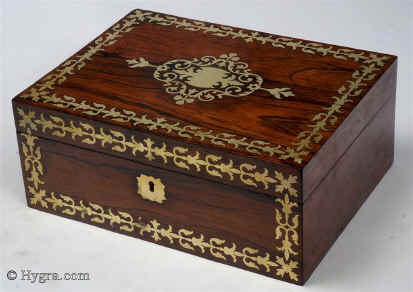
|
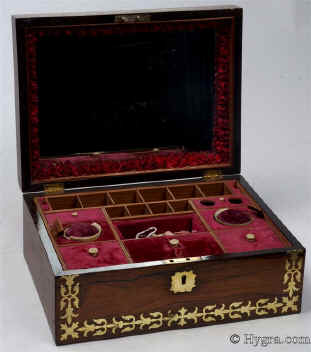
|
The tray is beautifully made in yew wood. This is most unusual. The velvet covers are original. There are two early 19th century pin cushions which fit snugly in purposely cut-out circles. These pincushions are encased in turned and carved bone baskets. Such work is known as Dieppe work as it was mostly made by French refugees.
|
Please click on images to enlarge | slide show | thumbnail index |
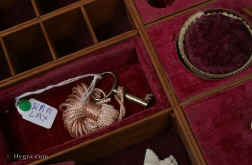
|
A
|
The velvet covers are original. There are two early 19th century pin cushions which fit snugly in purposely cut-out circles. These pincushions are encased in turned and carved bone baskets. Such work is known as Dieppe work as it was mostly made by French refugees.
|
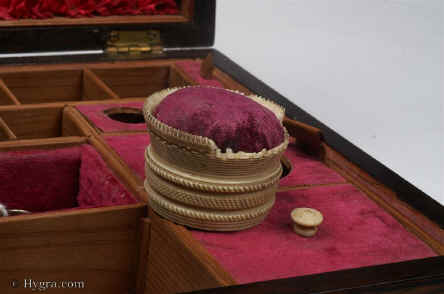
|
Please click on images to enlarge | slide show | thumbnail index |

|
Unfortunately the fragility of the baskets has caused them to suffer some damage, but they are quite lovely all the same.
|
Please click on images to enlarge | slide show | thumbnail index |
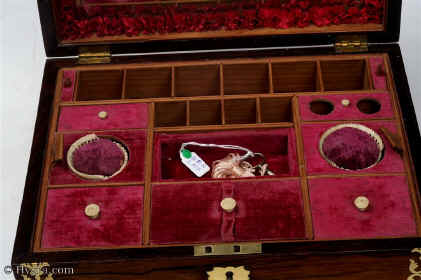
|
The tray is beautifully made in yew wood. This is most unusual. The velvet covers are original. There are two early 19th century pin cushions which fit snugly in purposely cut-out circles. These pincushions are encased in turned and carved bone baskets. Such work is known as Dieppe work as it was mostly made by French refugees.
|
Please click on images to enlarge | slide show | thumbnail index |
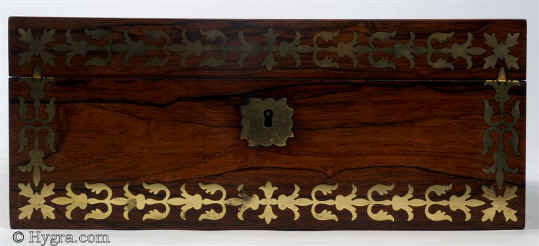
|
A
|
Please click on images to enlarge | slide show | thumbnail index |
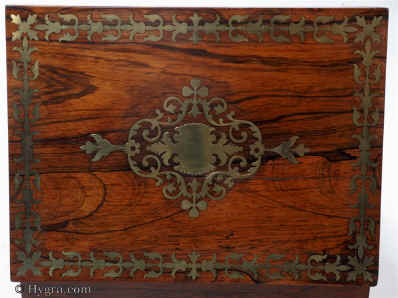
|
The design of the inlay is of highly stylized flora, suggesting neoclassical designs hinting at palmette and (on the top) acanthus motifs. The juxtaposition of dark wood with bold brass inlay was popular in the early part of the 19th century. The wood and the bright brass were mutually enhancing. The Prince Regent (later George IV) commissioned such work for his Royal palaces. This technique, which perfected control of cutting and inlaying, required time and skill and it was very expensive at the time. It is no wonder that such work was popular at a time when excess was rife and style was given supreme social importance.
|
Please click on images to enlarge | slide show | thumbnail index |
Please click on images to enlarge | slide show | thumbnail index |

|
A
|
Please click on images to enlarge | slide show | thumbnail index |
All text and images and linked images are ©
1999-2009 Antigone Clarke and Joseph O'Kelly. If you require any further
information on permitted use, or a licence to republish any material, email us
at copyright@hygra.com
| 